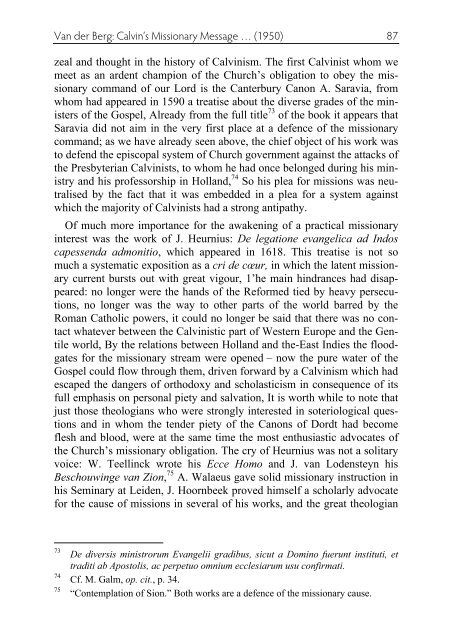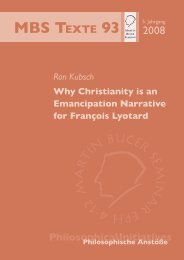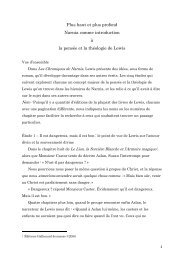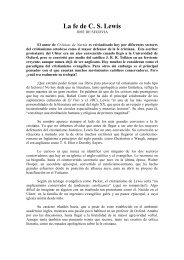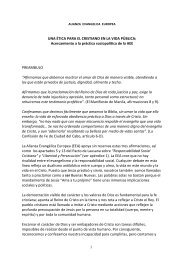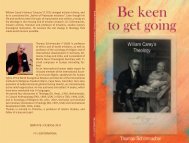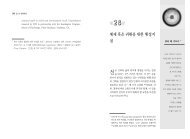Calvin and Missions - World Evangelical Alliance
Calvin and Missions - World Evangelical Alliance
Calvin and Missions - World Evangelical Alliance
Create successful ePaper yourself
Turn your PDF publications into a flip-book with our unique Google optimized e-Paper software.
Van der Berg: <strong>Calvin</strong>’s Missionary Message … (1950) 87<br />
zeal <strong>and</strong> thought in the history of <strong>Calvin</strong>ism. The first <strong>Calvin</strong>ist whom we<br />
meet as an ardent champion of the Church’s obligation to obey the missionary<br />
comm<strong>and</strong> of our Lord is the Canterbury Canon A. Saravia, from<br />
whom had appeared in 1590 a treatise about the diverse grades of the ministers<br />
of the Gospel, Already from the full title 73 of the book it appears that<br />
Saravia did not aim in the very first place at a defence of the missionary<br />
comm<strong>and</strong>; as we have already seen above, the chief object of his work was<br />
to defend the episcopal system of Church government against the attacks of<br />
the Presbyterian <strong>Calvin</strong>ists, to whom he had once belonged during his ministry<br />
<strong>and</strong> his professorship in Holl<strong>and</strong>, 74 So his plea for missions was neutralised<br />
by the fact that it was embedded in a plea for a system against<br />
which the majority of <strong>Calvin</strong>ists had a strong antipathy.<br />
Of much more importance for the awakening of a practical missionary<br />
interest was the work of J. Heurnius: De legatione evangelica ad Indos<br />
capessenda admonitio, which appeared in 1618. This treatise is not so<br />
much a systematic exposition as a cri de cœur, in which the latent missionary<br />
current bursts out with great vigour, 1’he main hindrances had disappeared:<br />
no longer were the h<strong>and</strong>s of the Reformed tied by heavy persecutions,<br />
no longer was the way to other parts of the world barred by the<br />
Roman Catholic powers, it could no longer be said that there was no contact<br />
whatever between the <strong>Calvin</strong>istic part of Western Europe <strong>and</strong> the Gentile<br />
world, By the relations between Holl<strong>and</strong> <strong>and</strong> the-East Indies the floodgates<br />
for the missionary stream were opened – now the pure water of the<br />
Gospel could flow through them, driven forward by a <strong>Calvin</strong>ism which had<br />
escaped the dangers of orthodoxy <strong>and</strong> scholasticism in consequence of its<br />
full emphasis on personal piety <strong>and</strong> salvation, It is worth while to note that<br />
just those theologians who were strongly interested in soteriological questions<br />
<strong>and</strong> in whom the tender piety of the Canons of Dordt had become<br />
flesh <strong>and</strong> blood, were at the same time the most enthusiastic advocates of<br />
the Church’s missionary obligation. The cry of Heurnius was not a solitary<br />
voice: W. Teellinck wrote his Ecce Homo <strong>and</strong> J. van Lodensteyn his<br />
Beschouwinge van Zion, 75 A. Walaeus gave solid missionary instruction in<br />
his Seminary at Leiden, J. Hoornbeek proved himself a scholarly advocate<br />
for the cause of missions in several of his works, <strong>and</strong> the great theologian<br />
73 De diversis ministrorum Evangelii gradibus, sicut a Domino fuerunt instituti, et<br />
traditi ab Apostolis, ac perpetuo omnium ecclesiarum usu confirmati.<br />
74 Cf. M. Galm, op. cit., p. 34.<br />
75 “Contemplation of Sion.” Both works are a defence of the missionary cause.


